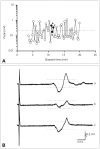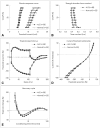The puzzling case of hyperexcitability in amyotrophic lateral sclerosis
- PMID: 23626643
- PMCID: PMC3633193
- DOI: 10.3988/jcn.2013.9.2.65
The puzzling case of hyperexcitability in amyotrophic lateral sclerosis
Abstract
The development of hyperexcitability in amyotrophic lateral sclerosis (ALS) is a well-known phenomenon. Despite controversy as to the underlying mechanisms, cortical hyperexcitability appears to be closely related to the interplay between excitatory corticomotoneurons and inhibitory interneurons. Hyperexcitability is not a static phenomenon but rather shows a pattern of progression in a spatiotemporal aspect. Cortical hyperexcitability may serve as a trigger to the development of anterior horn cell degeneration through a 'dying forward' process. Hyperexcitability appears to develop during the early disease stages and gradually disappears in the advanced stages of the disease, linked to the destruction of corticomotorneuronal pathways. As such, a more precise interpretation of these unique processes may provide new insight regarding the pathophysiology of ALS and its clinical features. Recently developed technologies such as threshold tracking transcranial magnetic stimulation and automated nerve excitability tests have provided some clues about underlying pathophysiological processes linked to hyperexcitability. Additionally, these novel techniques have enabled clinicians to use the specific finding of hyperexcitability as a useful diagnostic biomarker, enabling clarification of various ALS-mimic syndromes, and the prediction of disease development in pre-symptomatic carriers of familial ALS. In terms of nerve excitability tests for peripheral nerves, an increase in persistent Na(+) conductances has been identified as a major determinant of peripheral hyperexcitability in ALS, inversely correlated with the survival in ALS. As such, the present Review will focus primarily on the puzzling theory of hyperexcitability in ALS and summarize clinical and pathophysiological implications for current and future ALS research.
Keywords: amyotrophic lateral sclerosis; corticomotoneuron; gamma-aminobutyric acid; hyperexcitability; interneuron.
Conflict of interest statement
The authors have no financial conflicts of interest.
Figures



References
-
- Kiernan MC, Vucic S, Cheah BC, Turner MR, Eisen A, Hardiman O, et al. Amyotrophic lateral sclerosis. Lancet. 2011;377:942–955. - PubMed
-
- Kiernan MC. Hyperexcitability, persistent Na+ conductances and neurodegeneration in amyotrophic lateral sclerosis. Exp Neurol. 2009;218:1–4. - PubMed
-
- Section I: Alphabetic list of terms with definitions. Muscle Nerve. 2001;24:S5–S28. - PubMed
-
- Kleine BU, Stegeman DF, Schelhaas HJ, Zwarts MJ. Firing pattern of fasciculations in ALS: evidence for axonal and neuronal origin. Neurology. 2008;70:353–359. - PubMed
-
- Swash M. Why are upper motor neuron signs difficult to elicit in amyotrophic lateral sclerosis? J Neurol Neurosurg Psychiatry. 2012;83:659–662. - PubMed
LinkOut - more resources
Full Text Sources
Other Literature Sources
Research Materials
Miscellaneous

